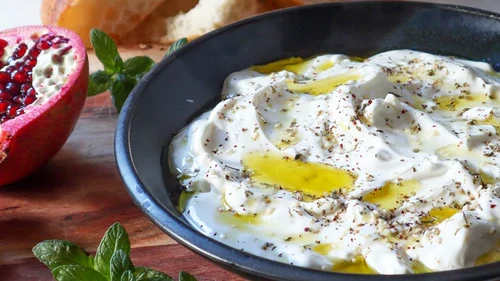Your Cart is Empty
Add description, images, menus and links to your mega menu
A column with no settings can be used as a spacer
Link to your collections, sales and even external links
Add up to five columns
Add description, images, menus and links to your mega menu
A column with no settings can be used as a spacer
Link to your collections, sales and even external links
Add up to five columns

Homemade goat milk labneh cheese (strained yogurt)
Barb Hodgens
Barb Hodgens loves to cook with alternative, healthy whole food ingredients, with a focus on gut health. Barb has overcome her own gut health issues through healthy eating. Share your ideas, comments and photos at the end of this post :)

A traditional delicacy.
Labneh is a creamy, concentrated yogurt cheese loved throughout the Middle East. It’s made by draining the water (whey) out of yogurt to form a dense, spreadable cream. Traditionally Labneh is made with sheep’s milk or goat’s milk but because of the availability of store-bought yogurt, cow’s milk is very often used now. We show you how to drip cow’s milk yogurt here or watch how on YouTube.
Making labneh from scratch means you end up with a gut loving probiotic delicacy. Thanks to the homemade goat milk yogurt base, the health benefits will surpass anything you can buy. The hardest part of making labneh cheese is waiting for it to drain. Everything else is simple. We promise the authentic rich and tangy flavour is definitely worth waiting for!

Labneh is an indispensable part of mezze platters. Traditionally it is adorned with extra virgin olive oil and seasoned with zaatar or mint and eaten with bread, but the uses for it don’t end there. You can dollop it onto salads or pizza in place of feta cheese or slather it onto sandwiches, and more!



Homemade goat milk labneh cheese (strained yogurt)
Luvele
Rated 5.0 stars by 1 users
Labneh is a creamy, concentrated yogurt cheese loved throughout the Middle East. It’s made by draining the water (whey) out of yogurt to form a dense, spreadable cream. Traditionally Labneh is made with sheep’s milk or goat’s milk but because of the availability of store-bought yogurt, cow’s milk is very often used now. We show you how to drip cow’s milk yogurt here or watch how on YouTube.
Ingredients
- 1-2 litres of homemade goat milk yogurt*
- Pinch of salt (optional)
- Extra virgin olive oil
- Zataar, dried mint or oregano
- *straining goat milk yogurt will lose up to half the volume. 2 litres of goat milk yogurt will yield approx. 3 cups of labneh
- Cheese or muslin cloth*
- A wooden spoon or similar
- Large jar or jug for capturing the whey
- A Thick rubber band
- Glass jar with airtight lid for storing the whey (optional)
- *We have found that some nut milk bags are not suitable straining homemade goat milk yogurt. The thin texture of goat milk yogurt will pass through synthetic fabric. We would hate for you to lose your batch of yogurt onto your bench or down the sink!
YOU ALSO NEED
Directions
- There are many ways to strain yogurt and you may need to get creative with your set up. In hot weather, it is best to let the yogurt strain in the fridge.
Spread your cloth over a sieve or colander that’s sitting in a large bowl (to catch the escaping whey)
Spoon the yogurt into the centre of the cloth.
You can tie off the cloth right away or let the yogurt strain open for a while first. Goat milk yogurt will strain faster than cow milk yogurt.
Draw up the four corners of the cloth and gently scrunch together. Do not squeeze as this blocks the cloth and slows down the natural separation and drip process.
- Use the rubber band to tightly tie the cloth together.
Push the wooden spoon through the rubber band and place it across the top of a jug like a rafter, allowing the yogurt pouch to hang down inside the jug. You may find another hanging method. There is no right way to do this. Make sure the yogurt bundle isn’t hanging down too far into the bowl – you want it to clear the whey that will collect at the bottom.
Leave the yogurt dripping for a minimum of 8 hours or overnight. For a firmer cheese, let it hang for 24 hours.
When it has stopped dripping you can unravel your bundle of yogurt cheese.
It’s ready to eat right away or can be stored in an airtight container in the fridge for approx. 2 weeks.
If you want to keep it fresh for longer, transfer the labneh into a sterile glass jar and cover with extra olive oil. Sealed from the air, homemade labneh will keep for several months in the fridge.
To serve, spoon the labneh into a shallow dish, sprinkle with salt, drizzle generously with olive oil and season with dried herbs.
Recipe Video
PIN THIS RECIPE

Homemade goat milk labneh cheese (strained yogurt)

A traditional delicacy.
Labneh is a creamy, concentrated yogurt cheese loved throughout the Middle East. It’s made by draining the water (whey) out of yogurt to form a dense, spreadable cream. Traditionally Labneh is made with sheep’s milk or goat’s milk but because of the availability of store-bought yogurt, cow’s milk is very often used now. We show you how to drip cow’s milk yogurt here or watch how on YouTube.
Making labneh from scratch means you end up with a gut loving probiotic delicacy. Thanks to the homemade goat milk yogurt base, the health benefits will surpass anything you can buy. The hardest part of making labneh cheese is waiting for it to drain. Everything else is simple. We promise the authentic rich and tangy flavour is definitely worth waiting for!

Labneh is an indispensable part of mezze platters. Traditionally it is adorned with extra virgin olive oil and seasoned with zaatar or mint and eaten with bread, but the uses for it don’t end there. You can dollop it onto salads or pizza in place of feta cheese or slather it onto sandwiches, and more!


:recipekit:
PIN THIS RECIPE

Subscribe
Sign up to get the latest on sales, new releases and more …
